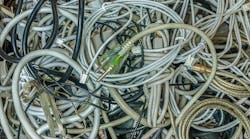Still Hooked Up: Cables and Connectors Seize the Day
In an electronics world that is evolving into a wireless future, there still is a need for cables and connectors to channel power and data intact to receiving components and instruments. According to a recent Electronic Cable Market Report1, the global cable market is predicted to reach $799.5 million by 2025, from $632.6 million in 2021, growing at a CAGR of 6% during the forecast period of 2021 to 2025. The global connector market, according to Allied Market Research, is predicted to reach $98.12 billion by 2027, at a CAGR of 6.7% between 2020 and 2027.2 Here are some recent news tidbits on what is happening on that front.
Ethernet Cables Protect Data in Harsh Environments
Electronic designs for the defense sector have their own mobility and portability goals driven by size, weight, and power (SWaP) requirements. Ethernet cables have been one component that has been difficult to shrink without performance sacrifices, until now. TE Connectivity's Raychem single-pair Ethernet (SPE) cables handle the harshest environments in aerospace, commercial, industrial, military, and space environments, providing critical interconnections in such applications as unmanned aerial vehicles (UAVs) and electric vertical takeoff and landing (eVTOL) aircraft.
“The single-pair Ethernet cable allows commercial and defense customers to maintain data rates, while reducing size and weight by up to 75% when compared to existing Quadrax systems,” said Lynden Bajus, product manager for TE’s Aerospace, Defense and Marine division. “TE’s ability to ruggedize an automotive standard to help meet the harsh environment requirements in aerospace, defense, and marine markets has allowed us to focus on improving size and weight parameters for our customers while continuing to maintain critical data-rate needs.”
The compact, lightweight construction of the Raychem SPE cables supports 100-Mb/s or 1-Gb/s data rates through single-pair cable assemblies (see figure above). The cables are standardized under the ARINC 854 cabin equipment network bus standard and are available in both AWG 24 and 26 cable sizes. They're designed for operating temperatures from –65 to +150°C. By complementing the firm’s 369 shielded connectors, the Raychem SPE cables reduce termination time and simplify maintenance compared to standard eight-wire cables and rectangular connectors.3
Report: High-Speed Connector Market Thrives with 5G
A report by Markets and Research values the high-speed connector market at $3,067.65 million in 2019 and predicts that it will grow to $5,658.42 million by 2027, at a CAGR of 8.3% from 2020 to 2027. The report attributes recent growth to the expansion of 5G and related devices in developed and developing countries, which increases demands for high-speed connectors. The report cites the additional high-speed requirements of 4G, VoLTE, and LTE as augmenting market opportunities for speedy connectors, once the fetters of the COVID-19 epidemic are in the past.4
Connections in Space
Basic down-to-Earth electronics components such as cables and connectors are also essential and critical items in the dark reaches of Earth orbit at the International Space Station. Such inconspicuous parts of the engineering marvel are subject to consistent inspection and maintenance in the harsh realities of space. NASA, in a brief mention, notes that Commander Akihiko Hoshide, of the seven-member Expedition 65 crew at the space station, checked power cables on the Confocal Space Microscope at the Kibo laboratory module on May 17. With ongoing research at the ISS (which is the length of a football field), cables and connectors play major supporting roles in the success and safety of the long-term mission in the hostile outer reaches of Earth’s gravitational influence.5
References
3. Microwaves & RF, “Ethernet Cables Speed Data in Harsh Environments,” April 21, 2021
4. Research and Markets, “Report: High Speed Connector Market,” January, 2021
